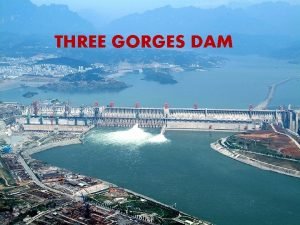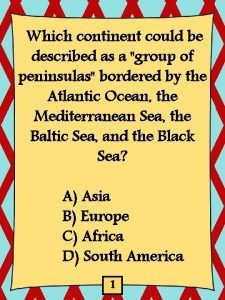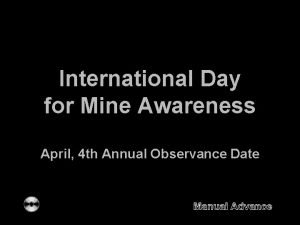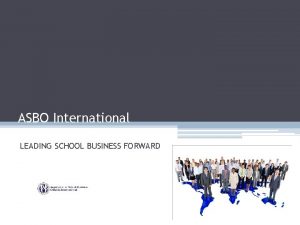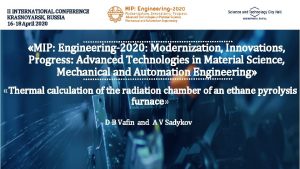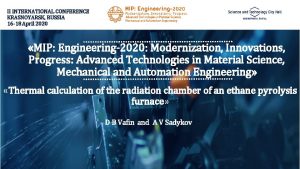II INTERNATIONAL CONFERENCE KRASNOYARSK RUSSIA 16 18 April





- Slides: 5

II INTERNATIONAL CONFERENCE KRASNOYARSK, RUSSIA 16 -18 April 2020 «MIP: Engineering-2020: Modernization, Innovations, Progress: Advanced Technologies in Material Science, Mechanical and Automation Engineering» «Thermal calculation of the radiation chamber of an ethane pyrolysis furnace» D B Vafin and A V Sadykov 1

02 Using our own application package that implements the differential method of thermal calculation of furnaces, we calculated the temperature fields in the radiation chamber and the distribution of heat fluxes along the tubular reactors in a ethane pyrolysis furnace. The interconnected combustion processes of fuel gas, the turbulent flow of combustion products, radiant-convective heat transfer are described by two-dimensional equations of transport and motion. Wall burners are installed in eight horizontal rows on both walls of the radiation chamber. Figure 1 shows one fourth of the radiation chamber of a furnace. The height of the radiation chamber along the x axis is 11 m, the depth along the z axis is 10 m and the width – is 2 m. On the lateral lined walls of the radiation chamber on eight rows are 64 burners on each side of the John Zinc type LPMW-5 with a rated power of 186 k. W. The percentage of fuel gas: H 2 – 18. 5; CH 4 – 78. 35; C 2 H 6 – 1. 6; N 2 – 1. 3; O 2 – 0. 25%. In the calculations, the temperature of the fuel gas supplied to the burners is assumed to be 60 °C. The lowest calorific value of the fuel is 29 Mj / nm 3. The temperature of the air supplied to the burners is taken equal to 2 °C. The coefficient of excess air = 1. 1. Figure 1. Scheme of the fourth part of radiation chambers of a tubular furnace ethane pyrolysis and coordinate system.

03 The differential method of thermal calculation of furnaces is based on concurrent integration of equations: 2 D equations of radiative transfer within approximation of discrete ordinate method (1), energy equation (2), turbulent flow of a gas mixture (3), two-parametric k turbulence model (4), continuity equation and gas state (5), convective-diffusion equation for transfer of air and fuel components (4): In our calculations, the tubular screen was considered as a wall with an effective degree of blackness of 0. 79. The degree of blackness of the inner surfaces of the walls is 0. 67. The temperature of the outer surface of the walls is 40 °C.

Figure 2 shows a view of the isotherms in the plane passing through the axes of the burners located in the area of the outlet pipes of the coil. Figure 3 shows graphs of changes in the flue gas temperature 04 at different distances from the side wall surface and a graph of the temperature of the inner surface of the lining in the same section. The use of a large number of wall-mounted burners with a multi-tiered arrangement on the side walls (in this case, 8 tiers) provides a fairly uniform thermal stress of the reaction pipes Figure 2. View of isotherms in the radiation chamber of a tubular ethane (Figure 4). pyrolysis furnace. Figure 3. Changes in the temperature of the combustion products at different distances from the side wall (y) and the inner surface of the lining (Tw) along the height of the furnace. Figure 4. Distribution of surface densities of heat fluxes along the height of the tubular screen.

05 Calculations show that even when using a large number of wall burners, it is not possible to ensure a uniform distribution of temperature and heat stress of the coil pipes in the radiation chamber. However, you can achieve the desired composition of the target product by changing the fuel gas consumption. Contacts D B Vafin and A V Sadykov Nizhnekamsk Institute of Chemical Technology (branch) Kazan National Research Technological University E-mail: vafdanil@yandex. ru «MIP: Engineering-2020: Modernization, Innovations, Progress: Advanced Technologies in Material Science, Mechanical and Automation Engineering»
